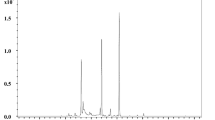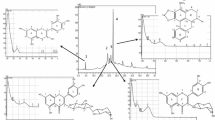Abstract
Senna septemtrionalis (Viv.) H.S. Irwin & Barneby (Fabaceae) is a medicinal plant used as a folk remedy for inflammation and pain. The objective of this study was to evaluate the anti-inflammatory and antinociceptive actions of an ethanol extract of Senna septemtrionalis aerial parts (SSE). The in vitro anti-inflammatory effects of SSE were assessed using LPS-stimulated macrophages and the subsequent quantification of the levels of cytokines (IL-6, IL-1β, and TNF-α) with ELISA kits, nitric oxide (NO), and hydrogen peroxide (H2O2). The in vivo anti-inflammatory actions of SSE were evaluated with the TPA-induced ear oedema test and the carrageenan-induced paw oedema test. The antinociceptive actions of SSE (10–200 mg/kg p.o.) were assessed using three models: two chemical assays (formalin-induced orofacial pain and acetic acid-induced visceral pain) and one thermal assay (hot plate). SSE showed in vitro anti-inflammatory actions with IC50 values calculated as follows: 163.3 µg/ml (IL-6), 154.7 µg/ml (H2O2) and > 200 µg/ml (IL-1β, TNF-α, and NO). SSE showed also in vivo anti-inflammatory actions in the TPA test (40% of inhibition of ear oedema) and the carrageenan test (ED50 = 137.8 mg/kg p.o.). SSE induced antinociceptive activity in the formalin orofacial pain test (ED50 = 80.1 mg/kg) and the acetic acid-induced writhing test (ED50 = 110 mg/kg). SSE showed no antinociceptive actions in the hot plate assay. The pre-treatment with glibenclamide abolished the antinociceptive action shown by SSE alone. Overall, SSE exerted in vitro and in vivo anti-inflammatory actions, and in vivo antinociceptive effects by the possible involvement of ATP-sensitive K + channels.




Similar content being viewed by others
References
Aguilar A, Argueta A, Cano L (1994) Flora medicinal indígena de México. Instituto Nacional Indigenista México City, Mexico
Alemayehu G, Adane L, Abegaz BM (2010) A new bianthracene C-arabinopyranoside from Senna septemtrionalis. Nat Prod Commun 5(5):747–750
Allkin B (2017) Useful plants—medicines: at least 28,187 plant species are currently recorded as being of medicinal use. In: Willis KJ (ed) State of the world’s plants 2017. Royal Botanic Gardens, Kew, London (UK)
Alonso-Castro AJ, Rangel-Velázquez JE, Isiordia-Espinoza MA, Villanueva-Solís LE, Aragon-Martinez OH, Zapata-Morales JR (2017) Synergism between naproxen and rutin in a mouse model of visceral pain. Drug Dev Res 78(5):184–188
Alonso-Castro AJ, Alba-Betancourt C, Yáñez-Barrientos E, Luna-Rocha C, Páramo-Castillo AS, Aragón-Martínez OH, Zapata-Morales JR, Cruz-Jiménez G, Gasca-Martínez D, González-Ibarra AA, Álvarez-Camacho DA, Devezé-Álvarez MA (2019) Diuretic activity and neuropharmacological effects of an ethanol extract from Senna septemtrionalis (Viv.) H.S. Irwin & Barneby (Fabaceae). J Ethnopharmacol 239:111923
Ankier SI (1974) New hot plate tests to quantify antinociceptive and narcotic antagonist activities. Eur J Pharmacol 27(1):1–4
Barreras-Espinoza I, Soto-Zambrano JA, Serafín-Higuera N, Zapata-Morales R, Alonso-Castro Á, Bologna-Molina R, Granados-Soto V, Isiordia-Espinoza MA (2017) The antinociceptive effect of a tapentadol-ketorolac combination in a mouse model of trigeminal pain is mediated by opioid receptors and ATP-sensitive K + channels. Drug Dev Res 78(1):63–70
Calhoun W, Chang J, Carlson RP (1987) Effect of selected antiinflammatory agents and other drugs on zymosan, arachidonic acid, PAF and carrageenan induced paw edema in the mouse. Agents Actions 21(3–4):306–309
Dinarello CA (1999) Cytokines as endogenous pyrogens. J Infect Dis 179:294–304
do Nascimento JET, de Morais SM, de Lisboa DS, de Oliveira Sousa M, Santos SAAR, Magalhães FEA, Campos AR (2018) The orofacial antinociceptive effect of Kaempferol-3-O-rutinoside, isolated from the plant Ouratea fieldingiana, on adult zebrafish (Danio rerio). Biomed Pharmacother 107:1030–1036
Flores-Ocelotl MR, Rosas-Murrieta NH, Moreno DA, Vallejo-Ruiz V, Reyes-Leyva J, Domínguez F, Santos-López G (2018) Taraxacum officinale and Urtica dioica extracts inhibit dengue virus serotype 2 replication in vitro. BMC Complement Altern Med 18(1):95
Guardia T, Rotelli AE, Juarez AO, Pelzer LE (2001) Anti-inflammatory properties of plant flavonoids. Effects of rutin, quercetin and hesperidin on adjuvant arthritis in rat. Farmaco 56(9):683–687
Hernandez-Leon A, Fernández-Guasti A, González-Trujano ME (2016) Rutin antinociception involves opioidergic mechanism and descending modulation of ventrolateral periaqueductal grey matter in rats. Eur J Pain 20(2):274–283
Inoue H, Mori T, Shibata S, Koshihara Y (1989) Modulation by glycyrrhetinic acid derivatives of TPA-induced mouse ear oedema. Br J Pharmacol 96(1):204–210
Jones L, Bartholomew B, Latif Z, Sarker SD, Nash RJ (2000) Constituents of Cassia laevigata. Fitoterapia 71(5):580–583
la Torre Fabiola VD, Ralf K, Gabriel B, Victor Ermilo AA, Martha MG, Mirbella CF, Rocio BA (2016) Anti-inflammatory and immunomodulatory effects of Critonia aromatisans leaves: downregulation of pro-inflammatory cytokines. J Ethnopharmacol 190:174–182
Nathan CF, Root RK (1977) Hydrogen peroxide release from mouse peritoneal macrophages: dependence on sequential activation and triggering. J Exp Med 146(6):1648–1662
Qiu X, Zhang J, Huang Z, Zhu D, Xu W (2013) Profiling of phenolic constituents in Polygonum multiflorum Thunb. by combination of ultra-high-pressure liquid chromatography with linear ion trap-Orbitrap mass spectrometry. J Chromatogr A 1292:121–131
Reichert JA, Daughters RS, Rivard R, Simone DA (2001) Peripheral and preemptive opioid antinociception in a mouse visceral pain model. Pain 89(2–3):221–227
Selloum L, Bouriche H, Tigrine C, Boudoukha C (2003) Anti-inflammatory effect of rutin on rat paw oedema, and on neutrophils chemotaxis and degranulation. Exp Toxicol Pathol 54(4):313–318
Singh J (1982) Two rhamnetin digalactosides and an oleanolic acid digalactoside from the flowers of Cassia laevigata. Phytochem 21(7):1832–1833
Singh J, Tiwari AR, Tiwari RD (1980) Anthraquinones and flavonoids of Cassia laevigata roots. Phytochem 19(6):1253–1254
Siqueira-Lima PS, Araújo AA, Lucchese AM, Quintans JS, Menezes PP, Alves PB, de Lucca Júnior W, Santos MR, Bonjardim LR, Quintans-Júnior LJ (2014) β-cyclodextrin complex containing Lippia grata leaf essential oil reduces orofacial nociception in mice—evidence of possible involvement of descending inhibitory pain modulation pathway. Basic Clin Pharmacol Toxicol 114(2):188–196
Wang Y, Chen P, Tang C, Wang Y, Li Y, Zhang H (2014) Antinociceptive and anti-inflammatory activities of extract and two isolated flavonoids of Carthamus tinctorius L. J Ethnopharmacol 151(2):944–950
Yoo H, Ku SK, Baek YD, Bae JS (2014) Anti-inflammatory effects of rutin on HMGB1-induced inflammatory responses in vitro and in vivo. Inflamm Res 63(3):197–206
Zamani Taghizadeh Rabe S, Mahmoudi M, Ahmadsimab H, Zamani Taghizadeh Rabe SS, Emami A (2014) Investigation of the biological activity of methanol extract from Eremostachys labiosa Bunge. Food Agric Immunol 25(4):578–585
Acknowledgements
This work was partially supported by the Directorate for Research Support and Postgraduate Programs (DAIP) at University of Guanajuato (DAIP, CIIC 67/2019, provided to AJAC). An experimental section of this work was supported by the program SEP-PRODEP (Apoyo a la Incorporación de Nuevos PTC, Grant Number: UDG-PTC-1438 Number 511-6/18/9169, provided to MAIE).
Author information
Authors and Affiliations
Corresponding author
Ethics declarations
Conflict of interest
The authors have no conflict of interest to declare.
Additional information
Publisher's Note
Springer Nature remains neutral with regard to jurisdictional claims in published maps and institutional affiliations.
Rights and permissions
About this article
Cite this article
Arana-Argáez, V.E., Domínguez, F., Moreno, D.A. et al. Anti-inflammatory and antinociceptive effects of an ethanol extract from Senna septemtrionalis. Inflammopharmacol 28, 541–549 (2020). https://doi.org/10.1007/s10787-019-00657-7
Received:
Accepted:
Published:
Issue Date:
DOI: https://doi.org/10.1007/s10787-019-00657-7




